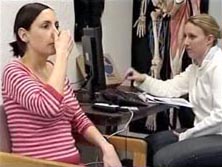S12 Respiration – Apnea

In Respiration 1, students observe physiologic modifications of the respiratory cycle associated with voluntarily increasing and decreasing blood carbon dioxide content by holding breath and hyperventilating. Students will qualitatively determine changes in respiratory minute volume by recording and analyzing EMGs from respiratory muscles of the thorax.
Experimental Objectives
-
To observe and record EMGs from thoracic respiratory skeletal muscle during eupnea, or normal unlabored breathing at rest.
-
To record changes in the EMG associated with modifications in the rate and depth of the respiratory cycle that occur before, during, and after periods of apnea vera and voluntary apnea and to compare those changes to eupnea.
Tasks Performed by the Student
-
Record EMG and respiration.
-
Breathe normally with mouth open.
-
Hyperventilate.
-
Recover from hyperventilation.
-
Hold breath.
-
Hyperventilate and then hold breath.
Videos
Biopac Student Lab Student Download
Student Prep & Distance Learning
Click the link(s) below for sample data and/or lesson procedure video(s), BSL PRO Lesson procedures (PDF) for human lessons*, and graph template files (*.gtl) for BSL PRO Lessons. If more than one .gtl is available, download the .gtl with the _suffix to match BSL version and hardware.
WHAT'S NEW
Biology research covers a wide variety of studies all aiming to understand living organisms...
Stay Connected